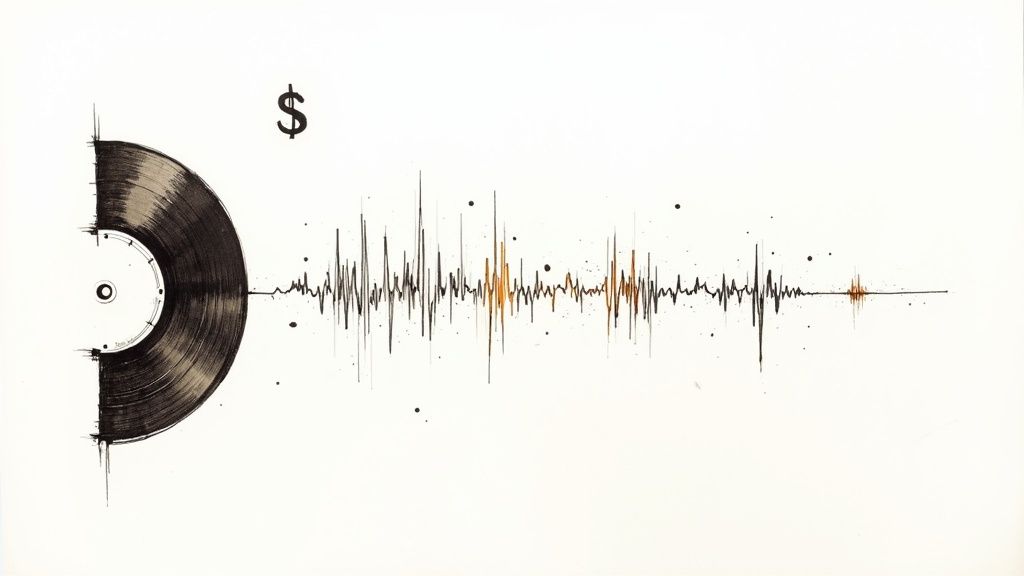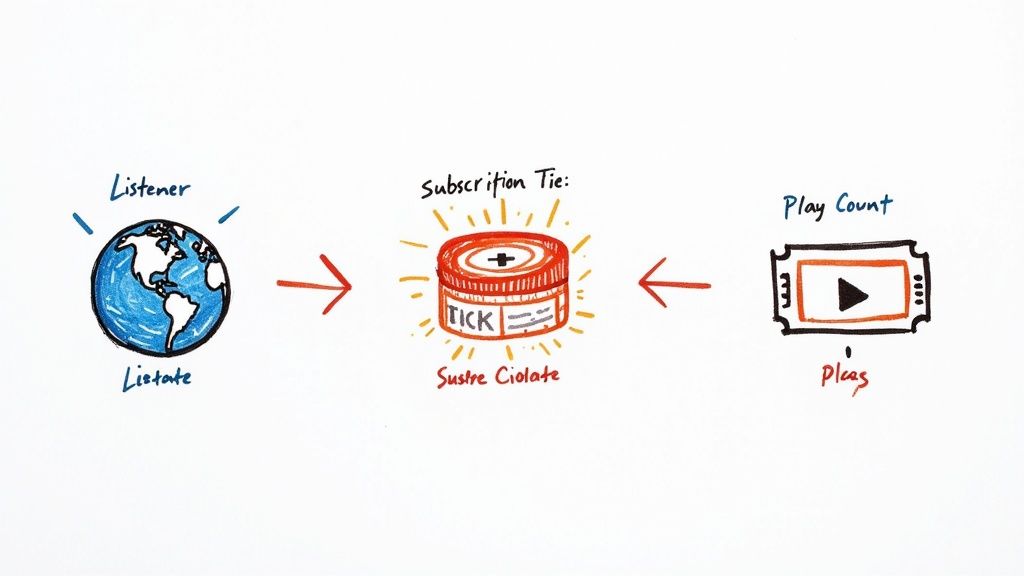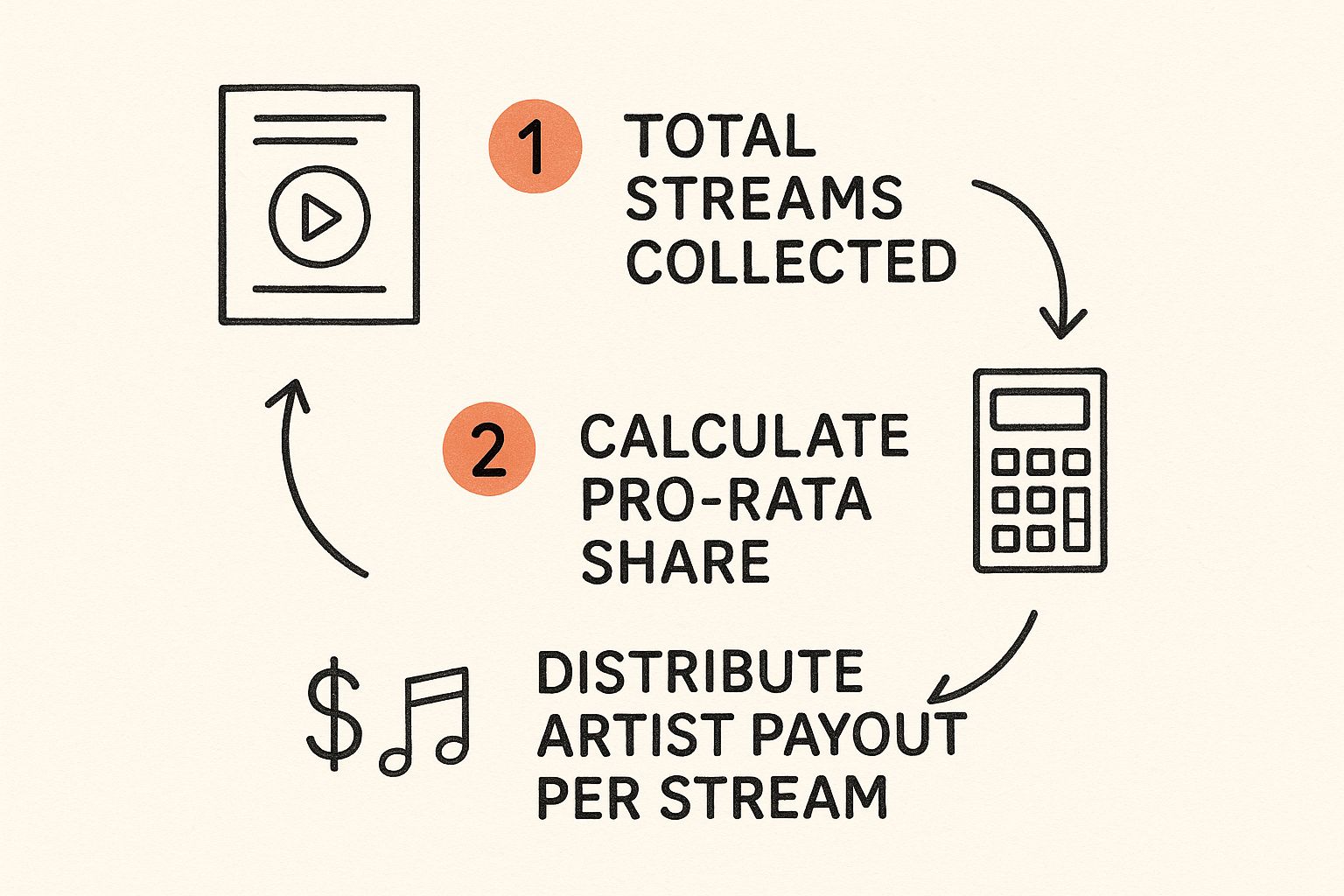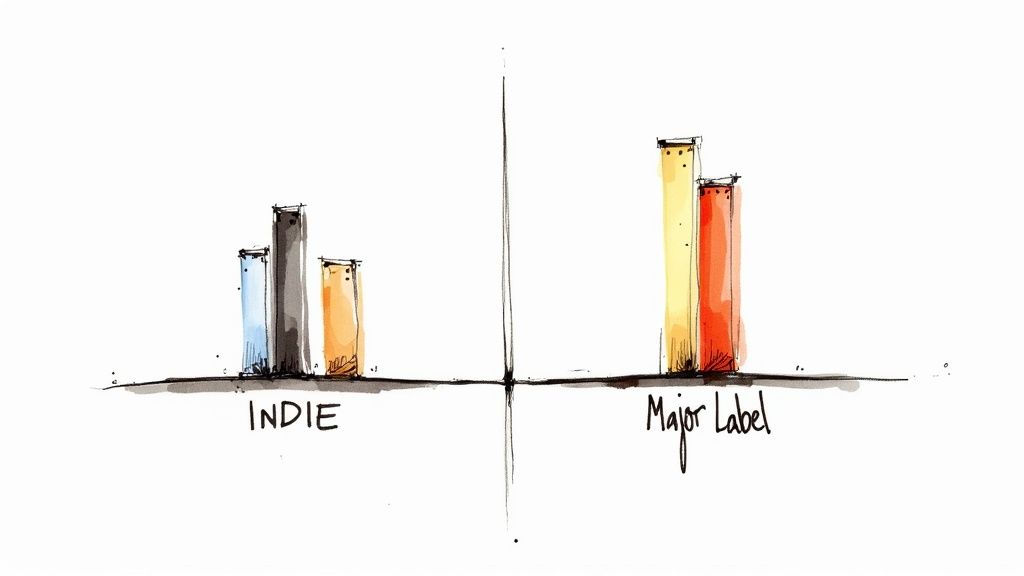Spotify Royalties Per Stream Explained | Maximize Your Earnings
- Valentin Delorelli
- Aug 7
- 14 min read
Alright, let's get straight to the question every artist has on their mind: how much does Spotify actually pay per stream?
You’ve probably seen the number floating around: $0.003 to $0.005 per stream. While that's a decent ballpark figure, thinking of it as a fixed rate is a huge mistake. It’s better to see it as just one piece of a much larger puzzle.
What One Spotify Stream Is Actually Worth

That simple per-stream number can be really misleading if you take it at face value. The truth is, the value of a single stream is constantly changing. One of the biggest myths new artists fall for is believing every single click on their song automatically nets them a consistent fraction of a cent.
The reality is way more nuanced. The money you earn is pulled from a massive, shared pot of revenue that Spotify calculates every single month. Your final payout comes down to your slice of that pie, and the size of your slice depends on a few powerful variables.
Key Factors That Change Your Payout
Understanding these variables is the first real step toward building a smart release strategy. Instead of obsessing over a single, universal rate, successful artists learn to recognize what makes that number tick up or down.
Here’s a quick rundown of what really moves the needle:
To give you a clearer picture, these are the primary variables that determine how much you actually pocket from each stream.
Key Factors That Influence Your Per-Stream Royalty Rate
Factor | Impact on Payout | Example |
|---|---|---|
Listener Subscription Type | High | A stream from a Spotify Premium subscriber pays significantly more than one from an ad-supported, free-tier listener. |
Listener's Geographic Location | High | A stream from a country with high subscription fees, like Norway or the US, is worth more than a stream from a region with lower prices, like India. |
Your Distribution Agreement | High | Your deal with a distributor or label dictates their cut. A 15% distribution fee means you keep 85% of what Spotify pays out. |
As you can see, where your listeners are and how they use Spotify have a direct impact on your bottom line.
The core takeaway is that not all streams are created equal. Your goal should be to understand which streams are most valuable and how to attract more of them.
Understanding the Royalty Pool
Here’s how it works behind the scenes. Spotify doesn't pay you a flat fee directly. Instead, it gathers up all the money it makes in a month from both subscriptions and ads. This becomes the "royalty pool."
Spotify takes its cut first (about 30%), and the remaining 70% is what gets paid out to all the rights holders on the platform—artists, labels, publishers, and so on. Your payout is based on your share of the total streams for that month. Industry analysis shows that for one million streams, an artist can expect to see somewhere between $3,000 and $5,000, but this depends entirely on that mix of listener types and locations. For more details, you can discover more insights about how Spotify pays artists and the factors that influence payouts.
This is just the high-level view of the mechanics. As we dig deeper, you'll see how all these pieces fit together, giving you the knowledge to move past just chasing stream counts and start focusing on what actually grows your revenue.
How Spotify's Pro-Rata Royalty Model Works

If you want to get your head around Spotify royalties per stream, the first thing you need to do is forget about a fixed rate. It's a common misconception. Spotify doesn't just pay a set price every time your song gets played. Instead, they use a pro-rata distribution model, which industry folks often call "streamshare." It’s way more fluid than a simple per-stream payout.
Think of it like this: every single month, Spotify gathers up all the revenue it made from Premium subscriptions and ad placements. All that cash gets dumped into one massive, collective pool. This pool is the total pot of money that gets paid out to every single rights holder on the platform for that month.
Your earnings aren't a flat fee for each play; they are your percentage of that total pool. So, if your tracks made up 0.1% of all streams on Spotify in a given month, you get 0.1% of that month’s revenue pool. Simple as that. This is the core reason your per-stream rate changes from month to month—you're always vying for a slice of a pie that's constantly changing in size.
The Great Big Royalty Pie
This pro-rata system means your earnings are completely dependent on how you perform against every other artist on Spotify. You aren't earning in a bubble. The more music that gets streamed across the entire platform, the more ways that central revenue pie gets sliced.
Let's use a simple analogy to make it stick:
Imagine a Pizza Party: Every month, Spotify throws a giant pizza party (this is the revenue pool). The size of the pizza changes based on how much money came in from subscriptions and ads.
Every Stream Is a Ticket: Each eligible stream on the platform acts like a raffle ticket. The more streams you rack up, the more tickets you're holding.
Sharing the Slices: At the end of the month, the entire pizza is divided up among everyone holding a ticket. If you hold 1% of all the tickets, you get 1% of the pizza.
That's the pro-rata model in a nutshell. Your payout is decided by your share of the total streams, not by some pre-set price for each listen.
Calculating Your Share of Streams
Spotify's system takes all its revenue from subscriptions and ads and creates that global income pool. From there, it's shared with rights holders based on their proportion of total streams. So, if your music accounts for 1% of all streams in a pay period, you'd get 1% of the distributable revenue after Spotify takes its cut of roughly 30%.
Key Takeaway: You get paid for your streamshare, not just your stream count. Getting a ton of streams is great, but it's your percentage of the total stream pie that really determines how much you earn.
Grasping this is fundamental. It shifts the focus from chasing a single, static number to understanding the bigger picture of platform-wide activity. For a deeper dive, check out our complete music royalties explained guide for artists, which breaks down how these payments are structured across the industry. This model is exactly why things like a listener's location and subscription type matter so much—they directly affect the value of the revenue pool you're drawing from. At the end of the day, your earnings are a direct reflection of your market share on the world's biggest streaming service.
Tracing the Path of Your Royalty Payment
So, you got your first Spotify royalty statement and… it’s a bit of a letdown. You did the math—total streams times the average spotify royalties per stream rate—but the number in your bank account is a lot smaller. Don't worry, it's not a mistake. Think of it less like a direct deposit and more like a cross-country road trip where everyone in the car needs a cut for gas and snacks.
That journey from a fan's click to your pocket is a winding road. Each stop along the way, another intermediary takes their contractually-obligated piece, shrinking the total before it ever gets to you. Getting a grip on this process is key to setting realistic financial goals for your music.
This infographic gives you a bird's-eye view of how the money flows.

It’s a simplified but essential map: Spotify pools all the stream revenue, calculates each artist's share, and then pays it out. That final step is where your money starts its real journey through all the different rights holders.
Who Gets Paid Before You Do
Once Spotify pays out the master and publishing royalties (which is roughly 70% of its total revenue), that money gets split up again. The people who get paid are the rights holders—the gatekeepers who own or manage the different copyrights tied to your song.
Every track generates two main types of royalties:
Master Royalties: This is for the sound recording itself. The payment goes to whoever owns the master, which is usually a record label or, if you’re independent, you.
Publishing Royalties: This is for the underlying song—the melody and lyrics. This money flows to the songwriter and their publisher.
These two streams of cash go down different paths, and each path has its own tollbooths where different stakeholders collect their fee.
For every song, there are two sets of copyrights being exploited: the sound recording (the 'master') and the musical work (the 'composition'). Both generate their own royalties, and understanding who owns what is key to knowing where the money goes.
A Tale of Two Artists
Let's see how this plays out in the real world. We’ll follow a hypothetical $1,000 royalty payment from Spotify for two very different artists. This really shows how much your specific deal structure can change your final take-home pay.
Scenario 1: The Artist with a Traditional Record Deal
For an artist signed to a major label, the payment chain is pretty complex. The label owns the masters, so they get the master royalties first.
Gross Royalty from Spotify: $1,000
Label's Share (e.g., 85%): The label takes its massive cut. In a common deal, the label might keep 85%, leaving just $150 for the artist's side of the ledger.
Recoupable Expenses: But wait! Before paying out that $150, the label deducts anything they've spent on you—marketing, music videos, recording costs, and that initial advance. If those costs haven't been "recouped," you see nothing.
Final Payout: If all expenses are paid back, the artist might see their $150. But more often than not, it's a lot less, or even zero, until that advance is fully repaid.
Scenario 2: The Independent Artist
Now let's look at an independent artist who owns their masters and uses a distributor like DistroKid or TuneCore. The path to payment is much more direct.
Gross Royalty from Spotify: $1,000
Distributor's Fee (e.g., 15%): The distributor takes their commission. If their fee is 15%, they get $150.
Final Payout: The artist gets the remaining $850—straight to them.
Seeing them side-by-side makes it obvious why going independent can be so powerful financially. Yes, a label offers big-time infrastructure and marketing power, but they also take the lion's share of the revenue. As an indie artist, you're the one steering the ship and handling your own promotion, but you keep a much larger slice of your Spotify royalties per stream, giving you way more control over your career and your finances.
Why Your Payouts Change Depending On Where Your Listeners Are
It might sound strange, but one of the biggest things that determines your spotify royalties per stream is the physical location of your listeners. Not every stream has the same value. A single play from a fan in one country can easily be worth several times more than a play from a fan somewhere else.
We call this the "Geographic Lottery," and it has a massive effect on your bottom line.
Think about it this way: you have two fans who love your new song. One lives in Norway, the other in India. Both are on Spotify's Premium plan and stream your track once. Despite the identical behavior, the stream from Norway will generate a much bigger payout for you. This isn't random—it's all tied to local economics and the way Spotify sets up its business across the globe.
The Economics of Global Streaming
Spotify’s model doesn’t just throw all the money into one giant, worldwide pot. Instead, it creates many different royalty pools for each country and for each subscription type (Premium vs. Free) within that country. The money generated in a particular market mostly stays right there in that market’s royalty pool.
This means a stream's value is directly connected to two key local factors:
Subscription Costs: A Spotify Premium subscription doesn't have a universal price. It costs a lot more in a high-income country like Switzerland or the United States than it does in a market with a lower average income. Higher subscription fees pump more money into that country's royalty pool, making every stream from that region more valuable.
Ad Market Strength: For listeners on the free tier, revenue comes from advertisers. The ad market in a country like the United Kingdom is way more developed and lucrative than in smaller, emerging markets. Because of this, ad-supported streams from countries with strong economies add more to their local royalty pools.
So, you aren't just earning a piece of a single global pie. You're actually earning a piece from dozens of different pies, and they all vary in size.
High-Value vs. Low-Value Markets
This system naturally creates a clear ranking of markets. A stream from a Premium subscriber in a high-value country can be a total game-changer for your earnings. For artists, knowing which countries pay the most isn't just a fun fact—it's data you can act on.
Let's break down how dramatic the difference can be with a hypothetical example.
Hypothetical Per-Stream Payouts by Listener and Region
This table shows just how much a listener's subscription and location can change the value of a single stream.
Listener Profile | Region | Estimated Per-Stream Payout |
|---|---|---|
Premium Subscriber | Norway | ~$0.0052 |
Premium Subscriber | United States | ~$0.0039 |
Premium Subscriber | Brazil | ~$0.0025 |
Ad-Supported Listener | United States | ~$0.0015 |
Premium Subscriber | India | ~$0.0013 |
Disclaimer: These are rough estimates that fluctuate monthly and are only for illustration.
As you can see, targeting listeners in a country like Norway could potentially double your income compared to focusing on listeners in Brazil, even if they're all Premium users. That's a powerful realization that can reshape your entire release strategy.
A stream is not just a stream. It's a financial transaction tied to a specific listener in a specific place. Understanding this is the difference between simply collecting plays and strategically building revenue.
By digging into your Spotify for Artists data, you can see exactly where your listeners are. If you spot a growing fanbase in a high-payout country like Germany or Australia, you can double down on that market. Run targeted ads, collaborate with local artists, or pitch to playlists popular in that region. Our guide on [how do artists earn money from Spotify](https://www.artist.tools/post/how-do-artists-earn-money-from-spotify-top-tips-for-2025) has more top tips for turning this kind of data into campaigns that actually work.
This geographic awareness transforms your listener data from a simple map into a powerful tool for maximizing your income.
Actionable Strategies to Maximize Your Earnings

Knowing how the spotify royalties per stream model works is one thing, but actually influencing it is how you build a real career. This is where we shift from theory to action. These aren't just generic tips; think of them as mini-playbooks for turning your streams into more meaningful cash.
The big idea here is to stop just asking for streams and start guiding which streams you get. By zeroing in on high-value listeners and learning to work with the algorithm, you can actively boost the value of your piece of the royalty pie.
Leverage Your Spotify for Artists Data
Your Spotify for Artists dashboard is more than just a place for vanity metrics—it's a treasure map. The "Audience" tab is where you should start. It shows you exactly where your listeners are tuning in from. As we've covered, streams from high-payout regions are worth a lot more.
See a growing fanbase in countries like the US, UK, or Germany? That's a huge signal. It's your cue to double down on those markets. You can start running targeted social media ads aimed at fans in those specific cities or countries, pushing them right to your Spotify profile.
This data also reveals how people find your music. Are they discovering you through another artist's radio, an editorial playlist, or their own "Release Radar"? This is gold. It tells you what's working so you can do more of it.
Master the Art of Playlist Pitching
Playlists are the single biggest discovery engine on Spotify. Getting your track on the right ones—both official and user-generated—is one of the most powerful moves you can make to jack up your stream count and, in turn, your royalty checks.
Official Editorial Playlists
Landing a spot on a Spotify-curated playlist is the holy grail. They are incredibly influential and can trigger a massive flood of new streams.
Pitch Early: Get your track submitted through the Spotify for Artists dashboard at least 7-10 days before it drops.
Be Specific: Your pitch needs detail. Talk about the song's mood, genre, and instrumentation. Mention any marketing or press you have lined up.
Target Wisely: Do your homework. Find playlists with a similar vibe and mention them in your pitch. It shows the editors you know what you're talking about.
User-Generated Playlists
Don't sleep on independent curators. These playlists can have thousands of dedicated followers and often act as a stepping stone to the bigger, official playlists. Use a tool like artist.tools to find relevant playlists in your niche and get contact info for the people who run them. A polite, personalized email can work wonders.
Getting playlisted isn't just about a quick stream boost. It sends strong signals to Spotify's algorithm that your track is catching on. This can lead to placement in algorithmic playlists like Discover Weekly and Release Radar, creating a snowball effect of continuous growth.
Target High-Value Listeners Directly
We know a Premium subscriber's stream pays more than a free user's stream. This knowledge should sharpen your marketing focus. While you can't directly target "Premium subscribers" on most ad platforms, you can use demographic and interest-based targeting to reach people who are more likely to pay for their music.
The whole streaming payout system has come a long way. With an average payout of $0.003 to $0.005 per stream, an artist needs somewhere between 200 and 330 streams just to earn a single dollar. To even get paid, Spotify now requires a track to hit at least 1,000 streams in the last 12 months—a move designed to make payouts more substantial and cut down on tiny, meaningless transactions.
Keep Your Music Relevant to the Algorithm
Finally, never forget that the Spotify algorithm loves consistency and engagement. To stay in its good graces, you need to keep your profile active and buzzing.
Engage Your Followers: Tell your fans to follow you on Spotify. It's the best way to guarantee your new releases land in their Release Radar.
Consistent Releases: You don't need a new album every year, but a steady flow of singles keeps your audience hooked and your momentum going.
Analyze Performance: Keep an eye on your stream data. If an older track suddenly starts getting traction, it might be the perfect time to give it another promotional push. To see what your streams might actually be worth, you can play around with our [Spotify royalties calculator](https://www.artist.tools/spotify-royalties-calculator) to project potential earnings.
Common Questions About Spotify Royalties
Even after you get a handle on the royalty model, a lot of artists still have lingering questions about how they actually get paid. The world of Spotify royalties per stream can feel like a maze, but clearing up these common sticking points will give you the confidence to navigate your career like a pro.
Let's dive right into the questions we hear most often.
How Often Does Spotify Pay Artists?
Spotify pays out royalties to rights holders every month, but don't expect that money to hit your bank account immediately. There's a built-in delay of about 60 to 90 days from the end of the month the streams happened. So, if you racked up streams in January, Spotify will likely send that money out around March or April.
But that's just the first step. From there, the money goes to your distributor or record label. They have to process everything on their end and then pay you according to their own schedule—which could be monthly, quarterly, or something else entirely. Always check your distribution agreement so you know exactly when to expect your earnings.
Do My Own Streams Count for Royalties?
Absolutely not. And trying to game the system this way is a seriously bad idea.
Intentionally looping your own music to juice your stream count is called "artificial streaming," and it's a direct violation of Spotify's rules. Their systems are incredibly sophisticated and built specifically to sniff out this kind of fraud.
If you get caught, Spotify can do a few things, and none of them are good. They can scrub the fake streams from your data, withhold your royalties entirely, or even pull your music off the platform for good. It's just not a legitimate or sustainable way to build your career.
Is There a Minimum Number of Streams to Get Paid?
Yes, and this is a relatively new change. A track now needs to have at least 1,000 streams within a 12-month period before it even becomes eligible to earn royalties. Spotify rolled this out to crack down on artificial streaming and make sure that the tiny payments being processed are for real, meaningful engagement.
This threshold also helps on the administrative side, ensuring the cost of processing a payment doesn't end up being more than the payout itself. Any money that would have gone to these ineligible tracks just stays in the main royalty pool to be distributed among all the other artists who met the threshold.
How Long Must Someone Listen for a Stream to Count?
For a play to officially register as a royalty-generating stream, someone has to listen for at least 30 seconds.
If they skip out at the 29-second mark, you get nothing for that play. This 30-second rule isn't just a Spotify thing; it's the industry standard across most major streaming platforms.
Ready to move from confusion to clarity? artist.tools gives you the data you need to stop guessing and start building a real strategy. Track your streams, find valuable playlists, and detect fraudulent activity to protect your career. Take control of your Spotify presence by visiting artist.tools today.
Comments